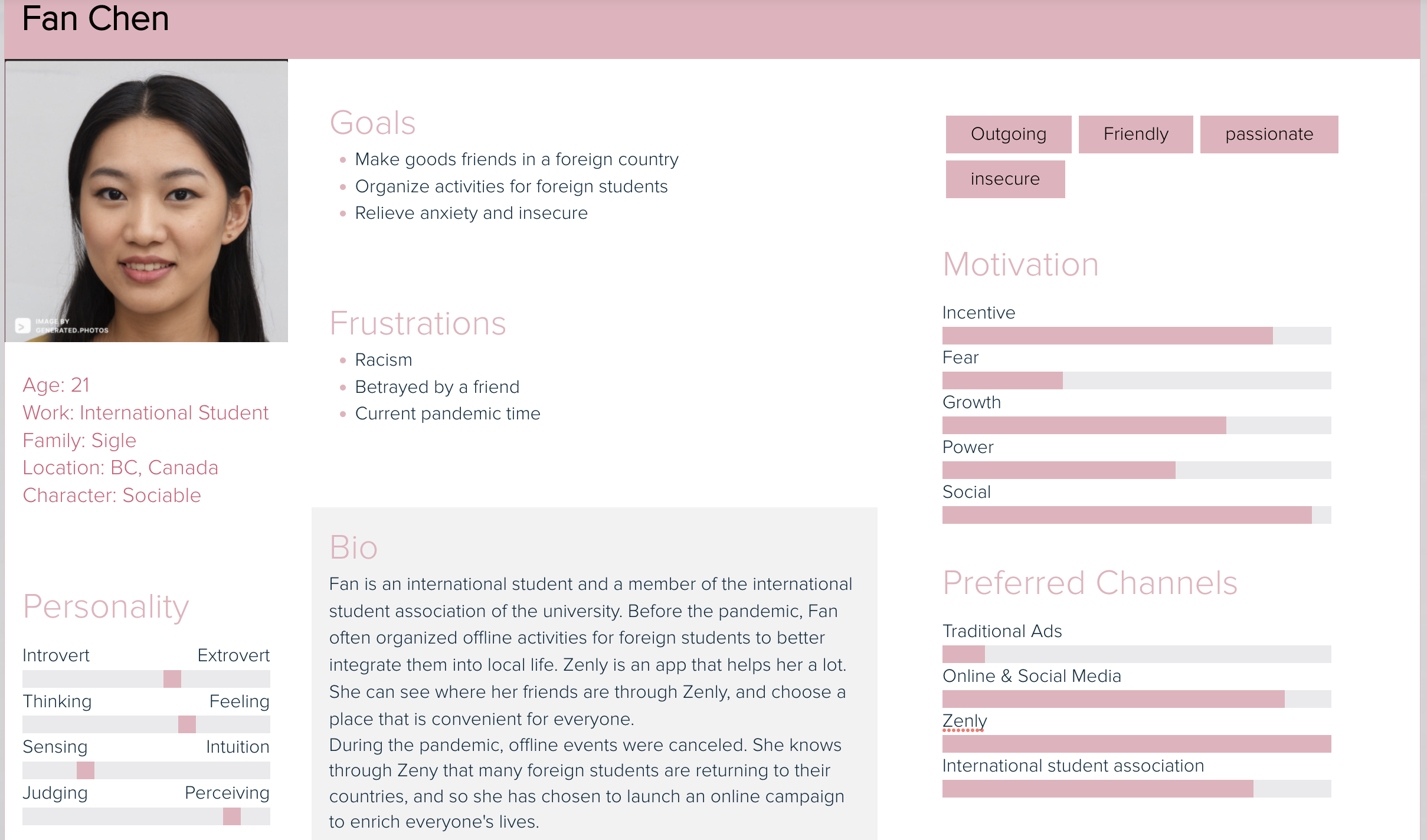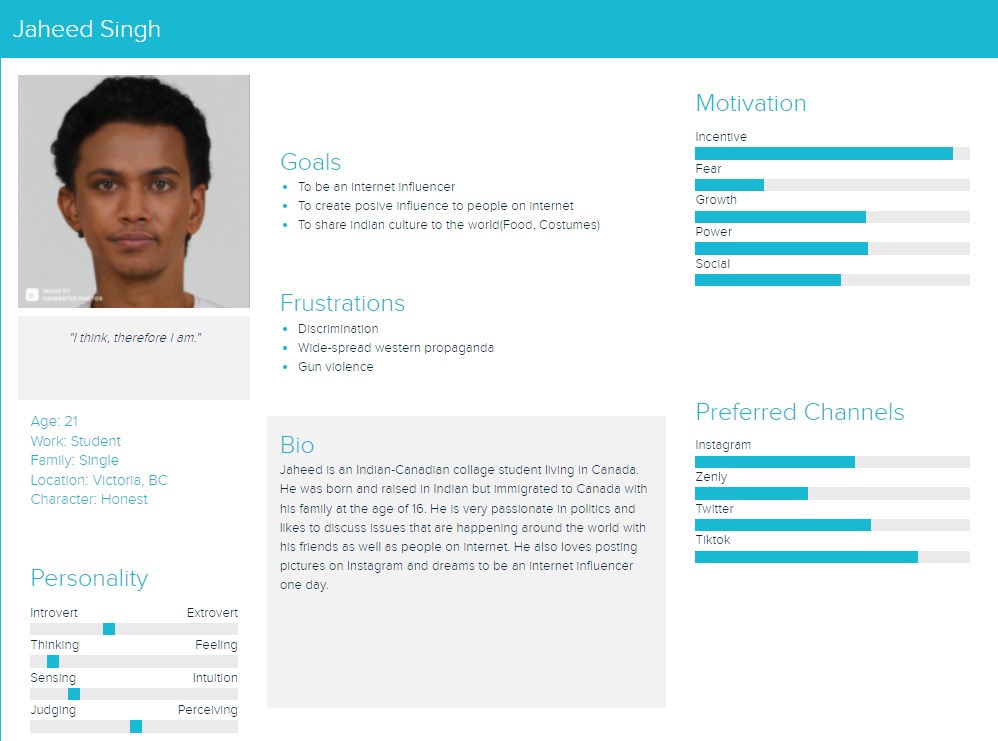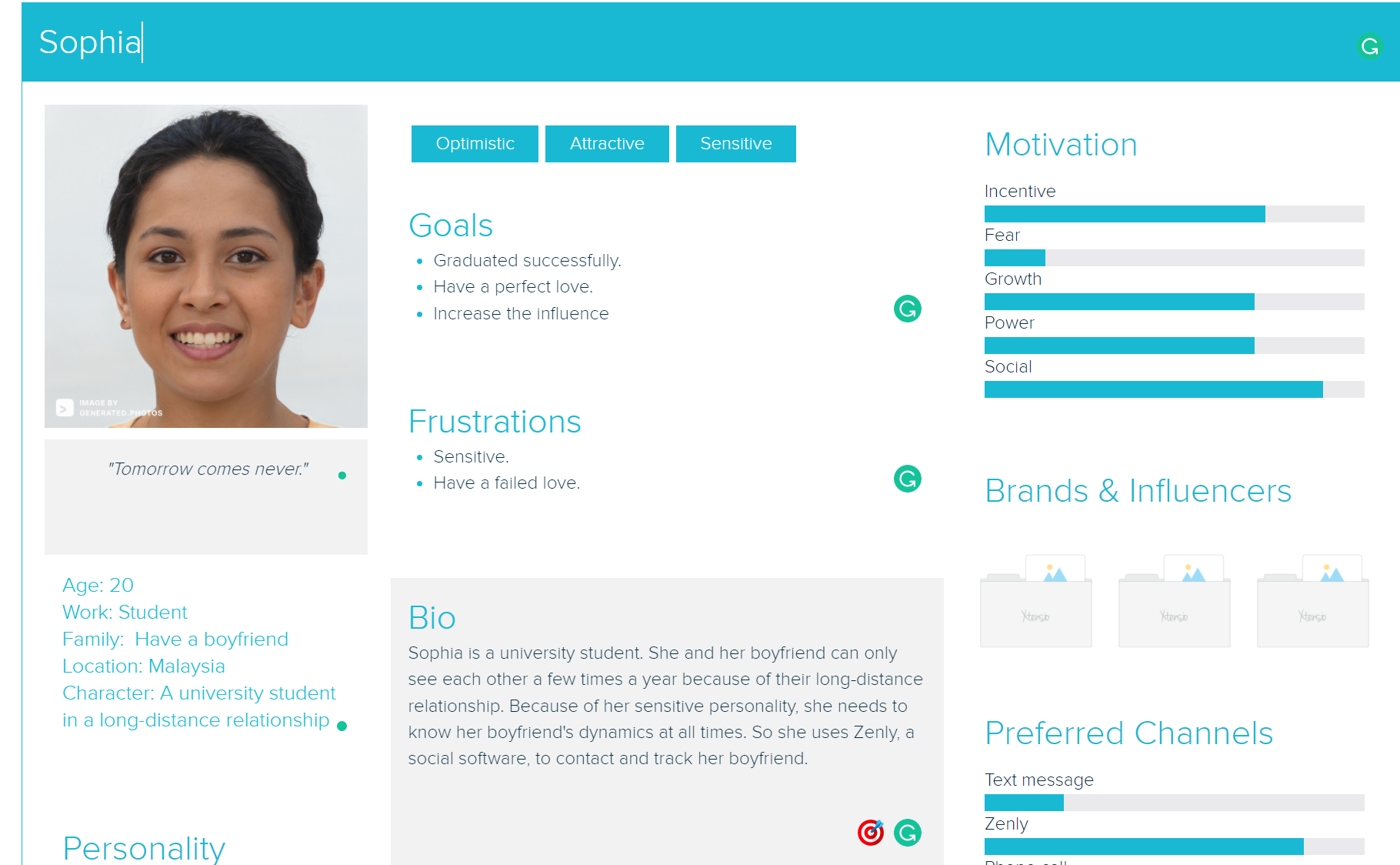Chapter 9 Zenly
9.1 Persona




9.2 Demographics
9.2.1 Target audience (age, demographics, political leaning, interests, hobbies, etc)
Friends and family members. Zenly is popular among teenagers.^https://en.everybodywiki.com/Zenly Zenly is an app that combines three functions: social, messaging, and mapping. Over 2 million people have downloaded the Zenly so far.
9.2.2 Can non-users browse or search content?
Non-users cannot browse or search content. You must first sign up.
9.2.3 How are users connected
(e.g., on some platforms, you request a connection which needs to be accepted, but on others, you can follow anyone without them reciprocating) When using Zenly, if users want to connect with other users, they must request to add other users as friends, and this request requires the other user’s acceptance. Only after the two users become friends, then they can chat with each other, view each other’s location, etc.
9.2.7 Is the parent company public or private?
The parent company Snap Inc. is an American camera and social media company, founded on September 16, 2011. by Evan Spiegel, Bobby Murphy, and Reggie Brown based in Santa Monica, California.
9.2.8 Who are the major investors?
According to the Crunchbase, the major investors are Benchmark, Peter Fenton, Jerry Murdock, Xavier Niel, and Olivier Thomas. Those investors have invested $22.5 million.
9.2.9 How does the company generate revenue?
Zenly does not have subscription and in-app purchase. The company will develop its own data mapping system to provide users with its own brand services.
9.3 Privacy and Surveillance
9.3.1 A link to your platform’s ToS and Privacy Policy
ToS: https://zen.ly/terms Privacy Policy: https://zen.ly/privacy
9.3.2 Your key takeaways from your examination of your platform’s ToS and Privacy Policy
Zenly states in their privacy policy that they may use user information to develop, operate, improve, present, maintain and protect Zenly’s services. And will send messages including emails.81 But may also share it with other users. Therefore, the user’s name, Zenly ID, friend list, number of friends, profile picture, locations visited, battery status and phone number are all viewable by people in the Zenly community. Zenly states that they will use users’ personal information within the scope of legal requirements.
9.5 Balancing your PLN and Public Discourse
9.5.2 What are the benefits to being in the public eye and having a PLN?
The Personal Learning Network (PLN) is a community of colleagues, mentors and experts with whom you can connect to improve your learning and take control of your professional development. PLN is not just a group of friends or family - it is an online community that can be used for many different purposes. The benefits of being in the public eye and having a PLN are many. Because PLN allows you to explore topics you have not been exposed to. And learn and communicate with a lot of people who have experience in that industry. This not only gets rid of the problems of geography and time, but also gives some good help to some special groups who lack education.87
9.5.3 Building community with online tools provided by an employer can be limiting, what are some possible restrictions and benefits?
There are many benefits to building a community using online tools provided by employers. The Internet is full of various online platforms that can help you connect and build online communities. If you want to create an online community, it’s important to research accessible platforms with features that make it easier for your community to collaborate. The latest technology is crucial to 93 percent of respondents when choosing an employer. Individuals and organizations can gain immediate productivity by utilizing technology that they are comfortable with in their everyday life. However, you should also be aware of some limitations. First, these tools can only be used when you have access to the Internet and a computer or device that is connected to the Internet. If you can’t do this, your organization may not be able to use them. Also, using these tools may not be practical for your organization if you don’t always have access to a computer or device connected to the Internet (for example, if you work in a remote location). Second, even though these tools can be accessed from anywhere, they do require you to have some level of technical knowledge and experience to function properly and effectively. This means that people without technical expertise may find it difficult or impossible to create content on these platforms without the help of others who are experienced in creating content on these platforms..88
9.5.4 Delivering information in a connected society requires verifiable resources, how can you ensure that you build a PLN you can rely on?
There are multiple ways of building a reliable PLN. First, we need to verify the source of information as well as certain websites including the reputation of the publisher and the expertise of the author. Secondly, we need to investigate the reliability of the information by searching coverage claims of certain information. Third, trace the most original source of the information to gain the full idea of certain information. The above steps allow us to follow reliable individual agent and organizations to learn information from various perspectives. We can also seek out building connections with people that our trusted individual agents are following so that we can expand our knowledge furthermore. The self engagement is also very important. Giving the fact that the half-life of information is only half a year long, we need to keep engaging with new materials and information so that we can keep a positive and reliable personal learning network.
9.5.5 How do those who are veteran story tellers minimize the risk of sharing misinformation?
The best way for veteran story tellers minimizing the risk of sharing misinformation would be 1.) Check the source of information to see if it’s credible and reliable, 2.) Verify the information with other reliable and credible sources to improve the credibility of the source, 3.) Thoroughly consider the emotional impact of the content before sharing the story, 4.) Combine data from credible sources with the story telling.
9.6 Digital Identity, Access and Inclusion, and Media Literacy (including Trust and Disinformation)
9.6.2 Access and Inclusion
How does the platform you chose for the Major Project incorporate accessibility and inclusion principles. How are disabled people treated on the platform? Are there multiple ways people can consume or produce content to meet accessibility needs? How do you include those who might otherwise be excluded? Zenly did not specifically introduce how it incorporates accessibility and inclusion principles. Unlike traditional social media apps. Zenly has its own gamified map that allows users to share location with their verified friends.As long as they have enabled location setting, users are able to see the status of their friends’ real-time location as well as battery percentage. It can be used by parents to check their children’s location and also can be used by caretakers to access the location of their patients as well as taking care of the elders with Alzhemiers and dementia. It is easily accessible and does not require any complex logic to master, so Zenly did incorporate accessibility and inclusion principle to some extent.
9.6.3 Media Literacy, Trust, and Disinformation
Does your chosen platform have content moderation policies? Does it flag disinformation, or provide links to trusted resources? How do you ensure that you don’t spread disinformation as misinformation? Zenly emphasizes that Users may not, and may not permit anyone to, use the Service in a manner that. Violate or infringe upon the publication, privacy, copyright, trademark, or other intellectual property rights of others; bully, harass or intimidate defame; send spam content to other users or engage in marketing practices.89 However, Zenly does not indicate that they have content moderation policies, which leaves it up to the users to determine the source and reliability of the information. According to Michael A. Caulfield’s WEB LITERACY FOR STUDENT FACT CHECKERS, there are four steps to check the reliability of network information: Check for previous work; Go upstream to the source; Read laterally; Circle back.90 In addition to all of the above, we still want to call for:
- Establish legal regulations and strengthen media regulation.
By establishing the relevant legal regulations can the problem of spreading false information be solved at the source. At the same time, we should strengthen the supervision of social media.
- Improve the quality of the audience and reject secondary dissemination.
The extensive participation of Internet users in information dissemination activities has produced a lot of negative influences and reduced them to emotional and extremist “rabble.” In social media, the audience has a significant role in disseminating information. The inherent mode of operation of social media, and the function of sharing, give the audience can also become the right to publish. So to reduce and eliminate the spread of false information. The audience should have the ability to identify incorrect information. At the same time, the audience should also have enough awareness to remind others to stop the re-circulation of false information.
- Establish an authority to release accurate information.
When false information that is difficult to identify is spreading widely, there is a need for an authoritative institution to analyze the accuracy of the information in detail and take corresponding measures to release official. Authoritative information to stop the continued fermentation and spread of false information as soon as possible.
https://community.zen.ly/hc/en-us/articles/4404799689361-What-s-Up-Moments-and-Memories-↩︎
Snapchat + Zenly - The Privacy and Security Risks of Location Sharing Apps | Turtler↩︎
https://www.quora.com/Whats-special-about-Zenly-the-location-app↩︎
https://www.socialmediatoday.com/content/how-celebrities-use-social-media-build-their-brand↩︎
https://www.teachhub.com/professional-development/2020/08/how-to-get-a-pln/↩︎
https://www.workplace.com/blog/online-community-management↩︎
Web Literacy for Student Fact Checkers – Web Literacy for Student Fact-Checkers (pressbooks.com)↩︎
9.4 Social Media and your PLN in Education
9.4.1 Describe how people are able to interact in your platform.
Can people leave comments on content? Is there a quick and easy way to ‘Like’ or ‘favourite’ something? Who sees that ‘like?’ Do creators generally respond to comments on their content? People can share locations with their friends in real-time on Zenly, and friends can see each other’s exact location, how fast they are moving, and the battery status of my phone. To take into account the privacy requirements of some users, they can turn off the background operation of the app. When people choose to use Zenly, it means they are willing to share their location and detailed status with people they trust. Zenly is a very easy-to-use app. First of all, you and your friends are on a map, and you can say hello by sending emojis. The more friends you have, the more emotes you can unlock. People can chat, share photos, videos in Zenly, but these are only visible to friends. Friends can respond to your post with a ‘like‘ emoji. Friends can see ‘like‘. The creator generally responds selectively and will reply to some questions that he considers more important.
9.4.2 How do educators use the platform.
What kinds of content are they teaching? Who is their audience? Do they respond to comments or questions? Are they using the platform as a PLN, or are they only creating content? To be honest, few educators use this software. Generally, educators will add a lot of friends at the beginning, such as friends of friends, and recommend friends. Educators can see the location and status of these friends, which is helpful for some offline organizations. Educators will share their work with their friends, and they can discuss it together. It is easy to find some like-minded friends and organize offline activities. They are using Zenly as a PLN because Zenly is a piece of software that requires a lot of interaction. When you become friends with each other, it shows that you trust each other, which is different from other platforms.
9.4.3 In your Learning Pod, plan and publish more than one *SHORT educational ‘post’ (whatever that looks like on your platform).
Don’t put huge amounts of effort into your post. A simple ‘ProTip’ or ‘LifeHack’ type of post, or a ‘Did you know…[something you know about…].’ Publish your posts on a few of your Learning Pod’s accounts. How do people respond to your post? Do they respond to the same post differently depending on the persona of the account? On Zenly, people mostly share moments of life with their friends. For example, ‘What’s Up (Moments and Memories).’ You can reply, send them your moments (which can be videos or photos), and you can save your sent and received moments to your memory. Except for your friends, no one else can see anything you post. Therefore, the replies received are all from friends. In the small video we sent, friends made very enthusiastic comments.82
9.4.4 Are there any concerns that educators should be aware of regarding your platform (privacy, age-inappropriate content, disinformation, misinformation, offensive or illegal content)?
Zenly privacy issues has been a controversial topic. Being Zenly friends means you need to share your location, phone battery power with your friends. Educators should be especially aware of privacy issues. Downloading and signing up for a Zenly account means that educators can view their students’ location, time, and battery information anytime, anywhere. To get all of this, educators need to follow students and get their feedback. We can think of this following and following back as request and respect, acknowledgment and permission. I followed you, which means I respect your privacy, so I should request before I get your details. I followed you back, which means I acknowledged our good relationship, so I permitted you to get my private information. However, private information such as a student’s location and phone battery is not very useful for educational purposes. At the same time, educators’ privacy is being exposed. So using Zenly as an educational platform should pay extra attention to privacy issues.83
9.4.5 Make note of other things you notice that a curious educator might want to know about your platform.
There are also some issues that educators should be aware of. The first point is that Zenly, also a GPS App, has an inaccurate and delayed positioning system. Whether educators are using the platform to observe students’ locations for their safety or as a teaching tool, the inaccuracy can negatively affect education process. The second point is that Zenly can set users location to be fixed. Even if the user is elsewhere, the user can simply locating his Zenly location to his home.84 This “deception” may protect the privacy of educators and students to a certain extent, but it does not have much positive impact on the education process. Also, since no password is required to create a Zenly account, anyone can use the Zenly account through the user’s device.85 So academics integrity become a new problem educators need to take into account.